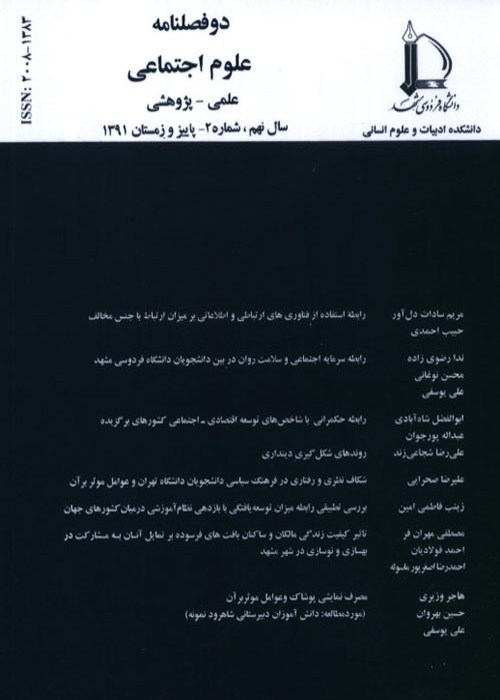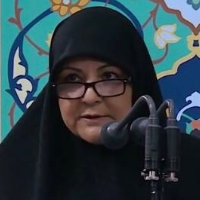The Typology of Post-Divorce Life Reconstruction Patterns
Author(s):
Article Type:
Research/Original Article (دارای رتبه معتبر)
Abstract:
1. Introduction
Divorce rate has been growing in recent years in Iran, resulting in an increase in the number of women and men involved with the post-divorce consequences. In the last five years, more than 800,000 divorces have taken place in Iran, meaning more than one and a half million men and women underwent divorce.A brief look at the literature of this field shows that despite the importance of the family system and the damage caused by divorce, there has been little sociological research in Iran on this issue with the adoption of qualitative approaches, and the few existing researches, all of which have used quantitative approaches, generally focus on negative effects of divorce on children, and little research has been conducted on the effects of divorce on the life of divorced men and women. Thus, the study of how divorced subjects encounter the consequences of divorce and the ways in which they rebuild their lives after divorce is a commonly neglected domain in Iranian sociology. The purpose of this study is to investigate the typology of life reconstruction patterns of post-divorce life.
2. Theoretical framework
The present research is devoid of a predetermined theoretical framework and subsequent hypotheses. But the sensitive theoretical concepts of this research are largely influenced by Bourdieu's theories on the different types of capital, habitus, and hysteresis.
3. Method
The present study is based on qualitative methodology and case study method. As such, by adopting a qualitative approach and semi-structured in-depth interview technique, we study the ways in which divorced subjects go through post-divorce reconstruction of their lives. This research also seeks the typology of a variety of patterns of reconstructing life after divorce. A type is a set of states or individuals that share at least one feature of the study.
4. Results and Discussion
The results of in-depth interviews with 36 divorced women and men in Tehran revealed four patterns of post-divorce reconstruction based on the subjective and objective specifications of respondents.These patterns include progressive reconstruction, two patterns of dual and transitional reconstruction, and retrograde reconstruction.Based on this, the individuals in the first category have favourable subjective and objective conditions after divorce and consider divorce as an act to improve their quality of life, and by taking an active and progressive approach ahead, they rebuild their lives successfully.But those who manifest the dual rebuilding patterns generally suffer from the hysteresis between the subjective and the external object, and if this incompatibility is resolved, they will be able to move towards either the first or the fourth reconstruction pattern in the future.Eventually, for subjects in the retrograde reconstruction category, the divorce event led to a backward and retrogressive motion due to their disadvantaged mentality and objectivity in dealing with post-divorce life.The findings also show that the subjective barriers to reconstructing life after divorce include: lack of psychological and emotional detachment from the ex-spouse, negative emotions and orientations towards divorce, traditional habitus, being non-religious, negative feedback of divorce among "significant others”.On the other hand, objective obstacles to the reconstruction of life after divorce include: old age at the time of divorce, unemployment, the lack of access to economic, social, and cultural capitals, having a child, long length of the marriage and short length of the post-divorce period.In addition, the subjective facilitators of post-divorce reconstruction include: psychological and emotional detachment from the ex-spouse, positive emotions and orientations towards divorce, modern habitus, being religious, positive feedback of divorce among "significant others”, and objective facilitators of post-divorce reconstruction include: young age at the time of divorce, employment, having access to a variety of economic, social, and cultural capitals, not having a child, short length of the marriage and long length of the post-divorce period.The findings of this study revealed that divorce causes many changes and challenges in various aspects of the life of the actors. Divorce requires emotional, sexual, psychological, economic, and social detachment. Compatibility with such detachments and efforts to create new connections leads to the success of actors in the process of reconstructing life after divorce.
5. Conclusion
The results of this study showed that divorce can be considered both a threat and an opportunity for the lives of actors, and it depends on the subjective and objective factors that play the role of barriers and facilitating conditions in the process of reconstructing life after divorce.Hence, the actors who have more facilitating conditions are more likely to be in the category of progressive reconstruction than others, and subjects that have barriers and disadvantaged mental and objective conditions generally undergo a passive and retrograde reconstruction.Based on the findings of the present research, it seems that to reduce the divorce traumas and facilitate the reconstruction of post-divorce life, one can use three categories of solutions, including economic, cultural, and social solutions, as well as educational and supportive strategies.It is also important to consider the individual backgrounds of the actants in allocating strategies. For instance, Supportive and educational solutions are more vital for the actors who have divorced recently, or economic strategies are more essential for women and especially those who do not have sufficient economic, social, and cultural capital or have custody of their children. Identification of different types of exposure of the actants during reconstruction, demonstrates the amount and the type of the required support to reduce their trauma. Therefore, this research emphasizes the need for doubled support and empowerment of the individuals involved with the retrograde reconstruction pattern in intervention programs.Keywords:
Language:
Persian
Published:
Journal of Social Sciences, Volume:15 Issue: 2, 2019
Pages:
1 to 32
magiran.com/p2019726
دانلود و مطالعه متن این مقاله با یکی از روشهای زیر امکان پذیر است:
اشتراک شخصی
با عضویت و پرداخت آنلاین حق اشتراک یکساله به مبلغ 1,390,000ريال میتوانید 70 عنوان مطلب دانلود کنید!
اشتراک سازمانی
به کتابخانه دانشگاه یا محل کار خود پیشنهاد کنید تا اشتراک سازمانی این پایگاه را برای دسترسی نامحدود همه کاربران به متن مطالب تهیه نمایند!
توجه!
- حق عضویت دریافتی صرف حمایت از نشریات عضو و نگهداری، تکمیل و توسعه مگیران میشود.
- پرداخت حق اشتراک و دانلود مقالات اجازه بازنشر آن در سایر رسانههای چاپی و دیجیتال را به کاربر نمیدهد.
In order to view content subscription is required
Personal subscription
Subscribe magiran.com for 70 € euros via PayPal and download 70 articles during a year.
Organization subscription
Please contact us to subscribe your university or library for unlimited access!



